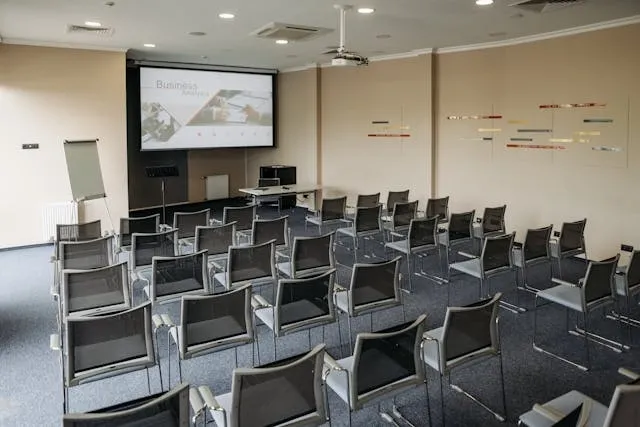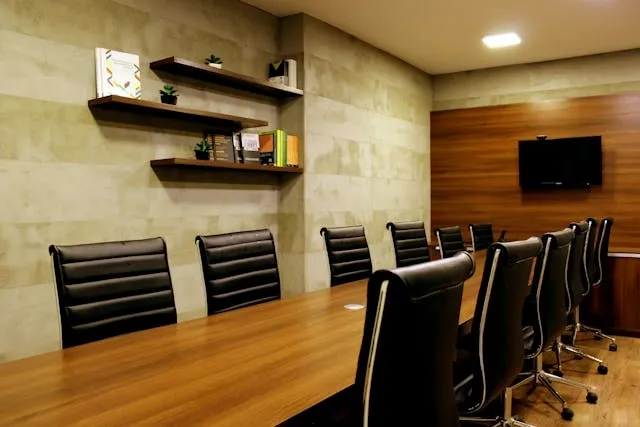Conference Room Setup: Seating Layout, Screen Size And Efficiency Tips
A well-organized conference room setup is key to ensuring smooth meetings that boost productivity. The layout and equipment in the room are fundamental to supporting communication and collaboration. In this guide, we explore best practices for optimizing your conference room equipment setup, including technology, seating layouts, and tips for enhancing efficiency.

Key Takeaways
- The right conference room setup can enhance productivity and communication, so you should choose your layout and equipment based on meeting size and type.
- Proper seating arrangements ensure all participants are comfortable and able to engage. High-quality AV equipment is very helpful if you have remote attendees.
- The room’s aesthetic should promote a professional atmosphere, combining ergonomic furniture and modern technology.
- We supply high-quality custom professional table covers that can feature your company logo to enhance the room’s look and help with branding.
Table of contents
-
How To Do Conference Room Setup
-
How Do You Set Up A Video Conference Room Perfectly?
-
Is A Monitor Or TV Better For A Video Conference Room?
-
What Is The Best Layout For A Conference Room Setup?
-
How Do You Make Your Conference Room Look Professional?
-
What Is The Role Of A Conference Room Setup In Hybrid Work?
-
What Are The Best Ideas For Small Conference Room Setup?
How To Do Conference Room Setup
There are several key steps to efficient conference room setup for maximum productivity:
- Determine the room’s purpose and the expected number of attendees at meetings. This will help make decisions about layout, table size, and AV equipment.
- Arrange seating to allow all participants to see the presentation screen and engage with the speaker. Common configurations include boardroom, U-shape, and classroom setups.
- Install a high-quality AV system that includes projectors, microphones, and speakers. Test everything beforehand to ensure a smooth execution of the meeting. For hybrid meetings, the equipment should cater to both in-person and remote participants.
- Enhance branding in the room. Our custom print-on-demand tablecloths can help add a professional touch and reinforce company identity.
All these elements help to create a positive environment for meetings.

What To Do Conference Room Equipment Setup?
As you are setting up a conference room, the right equipment is essential to create a productive meeting environment. A planning checklist may be helpful to get started. Here are some tips for this stage of your preparations:
- Ensure the basics are in place. A projector or monitor, microphones, speakers, and reliable internet connectivity are all essential.
- Hybrid meetings will need a high-definition camera, and you may need multiple cameras for larger spaces.
- Advanced AV solutions like wireless presentation tools and smartboards may enhance the overall experience.
- Ensure good cable organization. Hide cables using various methods to maintain a clean appearance.
- A room designed for larger meetings should include ceiling-mounted speakers and wall-mounted microphones for even distribution of sound.
- Don’t forget to integrate conferencing software that will support both in-person and remote attendees.
- Establish a control system that facilitates easy access to all AV tools so transitions between presenters and multimedia is seamless.
How Do You Set Up A Video Conference Room Perfectly?
Setting up a video conference room takes thoughtful planning to accommodate both in-person and remote participants. Start by choosing a central location for the camera. It is best to position it at eye level, and it needs to cover the entire meeting area.
Good lighting is essential to ensure all participants in the video can see each other clearly. Overhead lighting isn’t the best solution - instead, consider soft, diffused lighting to eliminate shadows. Additionally, use high-quality microphones and speakers so that all voices can be heard clearly. Ceiling-mounted microphones are best for larger rooms.
Acoustic panels can be helpful for reducing noise and echo to maximize sound quality. Be mindful of internet speed and reliability as you don[t want video feeds to lag or drop. Aim to deliver clear sightlines to screens and cameras with the room layout, and consider things like rounded webcam covers for when the room is not in use.
Make a statement with out custom table covers!
Are you ready to stand out at your next event?
Order now and elevate your brand with our high-quality, personalized table covers.
Is A Monitor Or TV Better For A Video Conference Room?
You may find yourself considering the choice between a monitor or TV for your conference room audio/video setup. However, according to Biztech Magazine, the choice should be between a short-throw projector vs big TVs.
Monitors offer sharp resolution and are a good fit for small spaces where clarity is critical. They also offer direct integration and may have touch-screen capabilities. TVs, meanwhile, are larger and more versatile, so they may work better for medium-large conference rooms. They might have built-in smart features that can integrate with conferencing software. Projectors, meanwhile, can offer the best of all worlds.
Size matters, so choose a monitor, TV, or projector that is proportionate to your room size.
Where Should The TV Be In A Conference Room For Optimal Viewing?
The placement of a TV or other display screen in a conference room is crucial for optimal viewing and engagement. Ideally, you should mount the TV at eye level for seated participants so that everyone has a clear view without straining their necks.
As a general guideline, position the center of the screen around 48 to 60 inches from the ground. Consider the seating arrangement - no matter what setup you choose, all seats should have a direct line of sight to the screen. In larger spaces, multiple screens or a projector might be helpful to ensure everyone can see the presentation.
The distance between your screen and the furthest participant is an important consideration. Typically, a distance of 1.5 to 2.5 times the screen’s diagonal size is optimal.
Best Solutions For Conference Room Audio Setup?
Audio quality is crucial in a conference room tech setup, particularly for clear communication in remote meetings or hybrid setups. Make the right microphone choice from the outset:
- Tabletop microphones: These work well for smaller spaces.
- Ceiling-mounted/boundary microphones: These offer even sound coverage in larger rooms.
Speakers should be placed strategically so that everyone can hear without distortion or volume inconsistencies. Common choices include wall-mounted speakers and ceiling speakers.
For video conferencing, implement echo cancellation and noise-reduction technology for maximum clarity. Acoustic panels can help reduce sound reflections for a focused auditory environment. If your conference room is large, you may want to use wireless microphones so presenters have flexibility as they move around.

What Is The Best Layout For A Conference Room Setup?
There are different layout strategies for how to set up a conference room, and the best solution depends on the types of meetings you will hold. Here are some ideas:
- Boardroom layout: This is ideal for smaller meetings, seating participants around a central table for maximum collaboration.
- U-shape layout: These work well for presentation with some interaction, facilitating a clear view of the presenter.
- Classroom layout: This is ideal for larger groups or training sessions, arranging participants in rows facing the presenter or screen.
- Theater-style seating: Use this option for large audiences where minimal interaction is needed.
- Banquet styles: Choose this for workshops or breakout sessions. Explore the best places to buy custom tablecloths to get the right look.
Your layout should be chosen carefully to optimize visibility, comfort, and engagement.
What Are The Different Styles Of Conference Room Setup?
As we have just noted, there are several different styles of conference room setups. Let’s look at when to use each style based on audience size and meeting type:
- Boardroom style: This involves a large central table, and it is best for smaller meetings with fewer than 15 attendees.
- U-shape style: This is best suited to presentations or discussions where visibility of the screen is of paramount importance.
- Theater-style: With rows of chairs facing the front, this approach works best for large presentations with minimal need for interaction between attendees.
- Classroom style: Similar to theater-style, this layout includes tables and works excellently for longer sessions that require note-taking.
- Banquet-style: Use this for interactive sessions, delivering small tables arranged in groups to encourage collaboration and small-groups discussions.
How Do You Choose The Right Seating Arrangement For A Conference Room?
It is down to you to choose the right seating arrangement for a conference room. You will need to consider several factors, like the meeting type, number of participants, and room size. Here are some suggestions:
- Collaborative meetings: A boardroom setup works best for this, seating participants around a central table.
- Presentation-based meetings: A classroom or theater-style setup will provide clear lines of sight to the screen and presenter.
- Workshops: This is where banquet- or cabaret-style seating using round tables works best.
Space and comfort are important considerations. There should be enough space for chairs to be moved without participants bumping into walls or each other. And make sure all participants have a clear view of screens or whiteboards being used. Custom-branded table covers can be great for adding a professional touch in any layout, so learn how to measure for a tablecloth and design yours with us.
Promote your brand with our custom table covers!
Ready to make a lasting impression at your next event?
Order now and showcase your brand with our eye-catching, personalized table covers.
Make Your Custom Table CoversHow Do You Make Your Conference Room Look Professional?
To create a professional look in your conference room, emphasize a clean, modern design that incorporates both functionality and aesthetics. Here are some suggestions:
- High-quality, ergonomic furniture: This will ensure comfort during long meetings.
- Color palette: Keep it neutral for walls and furniture, and complement this with modern lighting fixtures.
- Technology: Your tech should be integrated seamlessly. Make sure wires and cables are hidden seamlessly, and build monitors, projectors, and speakers into the room design.
- Custom element: Things like custom conference tablecloths with your company logo, to reinforce your brand during meetings with clients or partners.
- Functional decor: Plants, artwork, or subtle design elements can complement a room’s purpose.
Organize your conference room setup well for an aesthetically-pleasing, well-equipped meeting space.
What Are The Best Tips For Enhancing Your Conference Room Setup?
To give your conference room setup a lift, begin by focusing on comfort and technology. We suggest investing in ergonomic chairs and tables that promote productivity and minimize fatigue, particularly during long meetings.
Choose a seating arrangement that facilitates engagement, enabling attendees to communicate clearly. Ensure the room incorporates modern AV equipment for seamless video conferencing, such as:
- High-resolution screens
- Reliable microphones
- Speakers
Lighting is another key consideration. Combine natural and artificial lighting that is soft but effective. Integrate elements like acoustic panels to reduce noise distractions and add personal touches to enhance professionalism - consider how to choose a tablecloth design that lifts your visual identity and enhances the decor. Finally keep the room clutter-free, hiding cables and implementing organized storage for a polished atmosphere.
What Are The Best Practices For Organizing A Conference Room For Team Meetings?
To execute effective team meetings, conference room organization should emphasize space for collaboration and communication. Here are some ideas to consider:
- Seating: Arrange it in a way that encourages eye contact and conversation. A U-shape, or sitting around a central table, can help.
- Resources: Ensure all attendees can access things like notebooks, pens, or digital devices.
- AV setup: This should be reliable and deliver everything you need, particularly in hybrid meetings. Position screens, cameras, and microphones strategically.
- Smartboard: This, or a simple whiteboard, can facilitate brainstorming sessions and enhance idea-sharing.
- Space: Optimize this to allow easy movement whilst maintaining comfort.
Technology integration like WiFi connectivity and access to charging ports is easy. And consider providing attendees with customized full-color sublimation lanyards to help identify their roles in the meeting.
What Is The Role Of A Conference Room Setup In Hybrid Work?
Research has shown that prolonged camera use in meetings can lead to fatigue, which may affect same-day and next-day meeting performance. With that in mind, your hybrid conference room setup plays a pivotal role in creating a seamless experience and ensuring everyone remains motivated and productive.
The room should be equipped with advanced AV technology, including things like:
- High-definition cameras
- Microphones
- Speakers
You should also design the room for flexibility to allow for quick adjustments depending on the number of in-person attendees. Soundproofing is critical, particularly in open office environments, so that participants are not disturbed by background noise. And good lighting and camera angles ensure remote participants feel more connected.
Choose software solutions that support virtual collaboration tools. This will help ensure productive meetings that energize and engage participants.

Attract attention and make a statement at your next event with our high-quality, personalized table covers.
Showcase your brand with our custom table covers!
Order now and promote your brand in style.
What Are The Best Ideas For Small Conference Room Setup?
In a small conference room, you want to make maximum use of the available space without compromising functionality. Here are some ideas to make it work:
- Space-saving furniture like folding tables or stackable chairs use space efficiently.
- Seating should be comfortable but compact to ensure sufficient room to move around.
- Wall-mounted AV equipment helps free up valuable floor space.
- Multipurpose furniture, like tables with built-in charging ports, further increase space efficiency.
- Opt for wireless technology integrations to minimize clutter in the space.
- Lighting should be bright but not overwhelming.
- Acoustic panels are great to minimize echoes in a small room.
- Smart storage solutions, like built-in cabinets or shelves, help keep the space tidy.
- A simple, thoughtful layout will keep the space functional, and you can incorporate strategic decor like custom-fitted table covers for a sleek, tailored look on tables.
Frequently Asked Questions About Conference Room Setup
How To Do The Best Conference Room Setup?
The best conference room setup depends on the available space and purpose of your meetings. Prioritize seating arrangements, technology, and lighting, and incorporate ergonomic furniture throughout.
What Equipment Do You Need For A Conference Room Setup?
Essential equipment includes a high-quality projector, TV, or monitor, along with microphones, speakers, and reliable internet access. Advanced setups may include smartboards, video conferencing technology, and branded elements like custom table covers.